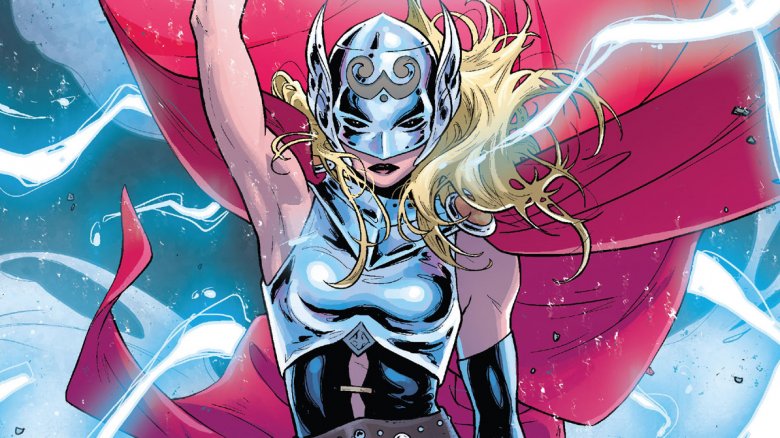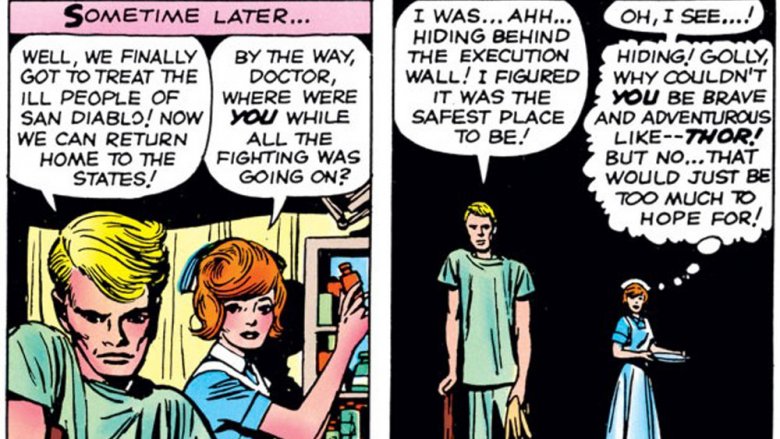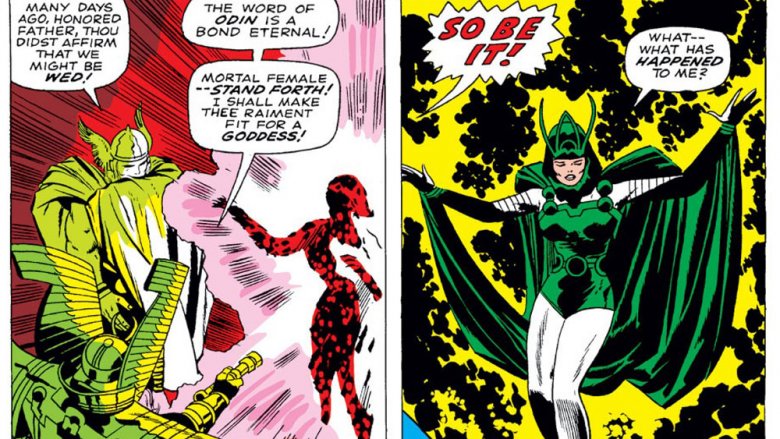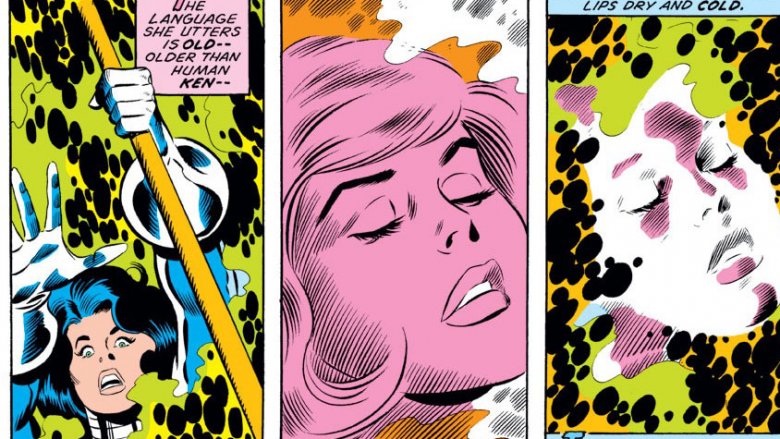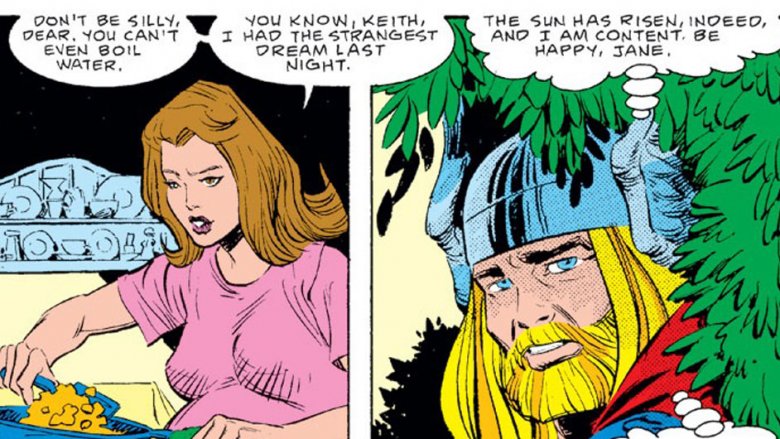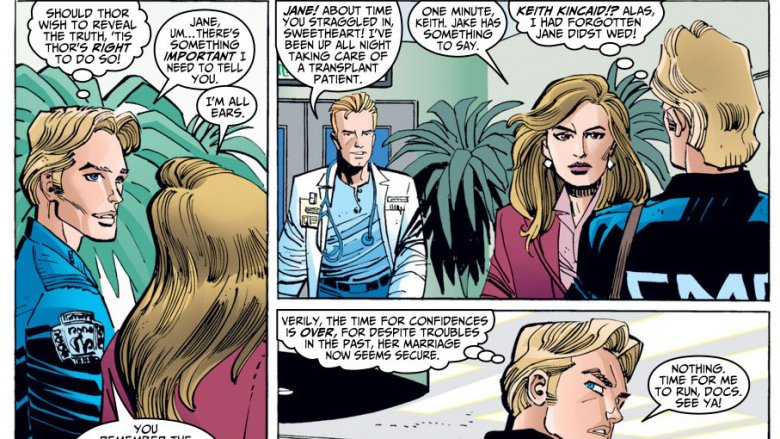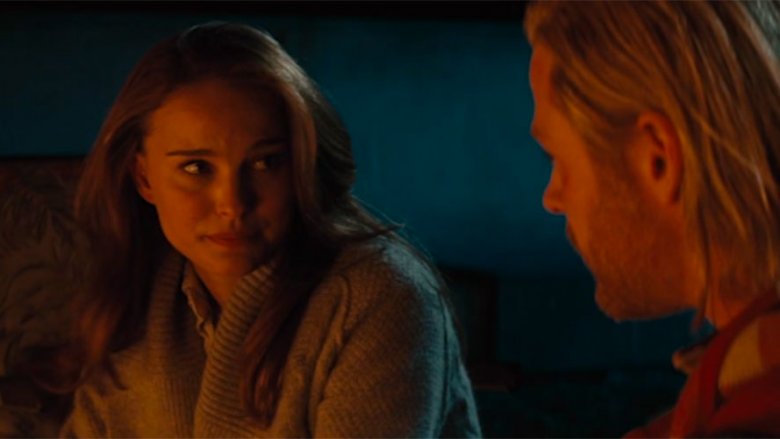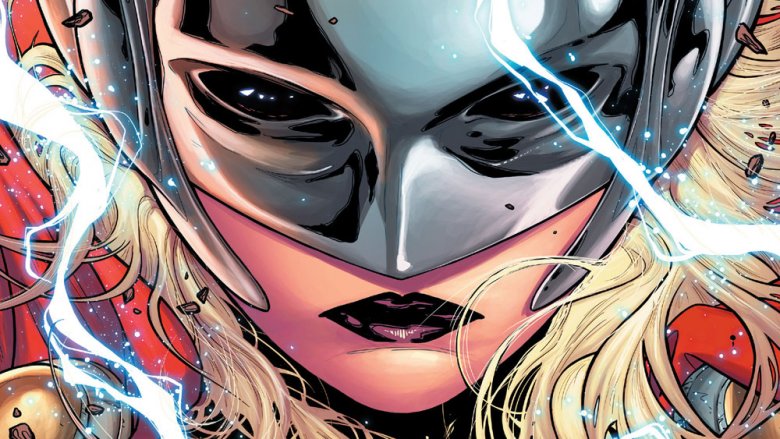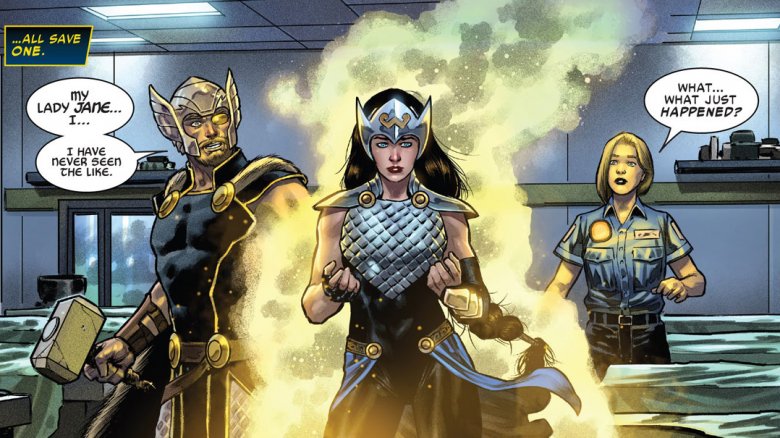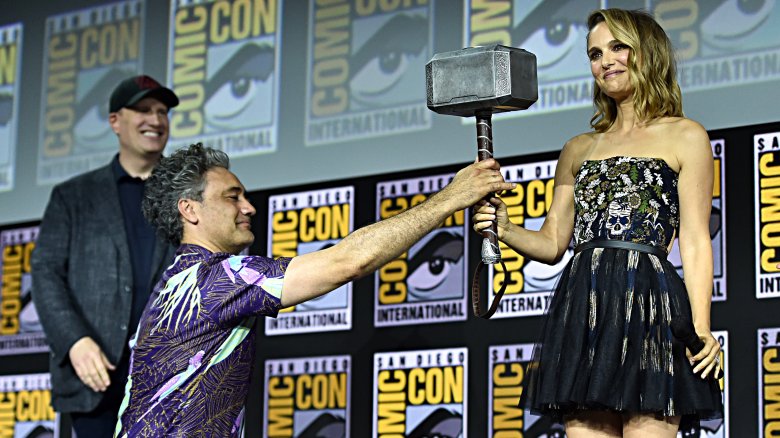The Untold Truth Of Jane Foster
If you had to place a bet on which character from the earliest days of Marvel Comics would grow to become one of the most important heroes on the company's roster, there's a good chance that Jane Foster would've had the longest odds of the entire bunch. Originally introduced in 1962 as the most minor of supporting characters, she started out her fictional life as little more than a mandatory love interest for Thor.
Cut to 2019, however, and she's about as far from that one-dimensional romance as she can be, but it's been a pretty strange road to get there. From seeming so unimportant that she was written out of the book to proving herself worthy to carry the title of the Mighty Thor — and plenty of comics-worthy twists and turns over the decades in between — here's the truth behind Jane Foster.
Just another Lois Lane?
Jane Foster was introduced in Journey Into Mystery #84, only a month after Thor himself made his first appearance in the previous issue. While #83 had been devoted to introducing the world to Dr. Don Blake and his thundering alter ego — and having him fight a bunch of aliens made of rocks — the following issue took a little time to fill out Thor's supporting cast, and it's not tough to figure out where creators Stan Lee and Jack Kirby were drawing their inspiration.
If Thor — the ridiculously powerful godlike being from another world whose secret identity was a mild-mannered, unassuming human — was easy to see as Marvel's take on Superman, then Jane Foster was Lee and Kirby's riff on Lois Lane. Like her counterpart at the Distinguished Competition, she was the coworker that the hero was pining for, who was far more interested in the superhero than the secret identity. The only big difference was that Jane was a nurse working with Blake rather than a reporter — and that, at least in her first few appearances, Jane was a redhead rather than a brunette.
That's how she started out, anyway. Over the next few years, Jane would distinguish herself from Lois — and most of the other standard-issue love interests in superhero comics — by learning Thor's secret identity and being brought into the mythologically inspired world of Asgard... for a little while.
Jane vs. Godhood, Part One: Into the Unknown
Eventually, Thor and Jane's romance got to the point where they wanted to be married. If you're familiar with how superhero comics in the '60s regarded the concept of marriage, though, it probably won't surprise you to learn that it didn't exactly work out. The major obstacle for this set of lovebirds came in the form of Thor's father, Odin, who forbade the marriage on the grounds that Thor was an immortal Asgardian thunder god, and Jane... was not. There's a pretty simple solution that problem, though: just go ahead and make Jane a goddess.
That's what happens in 1967's Thor #136, when Thor takes Jane home to Asgard to meet the family. Odin, in a seemingly benevolent move, uses his considerable power to turn Jane into a goddess, granting her a wild new costume and the power of flight. Unfortunately for Jane, this gift comes with a few strings attached. She has to prove that she had "the courage of an immortal" in order to stay in Asgard, and Odin decides that the best way to test Jane's bravery is to lock her in a dark room with the Unknown, a Lovecraftian horror that can only be summoned by a gigantic magic tuning fork. This is all pretty weird, but to be fair, it's no weirder than actual Norse mythology, in which the universe comes into existence by being licked out of a glacier by a cosmic cow.
Needless to say, Jane freaks out upon being confronted with the Unknown, and declares her desire to "escape from this world of fear and madness!" With that, Odin declares her unfit, strips her of her short-lived powers, and boots her back to Earth without any of her memories of Thor. Instead, she's given a job with hunky doctor Keith Kincaid, with whom she immediately falls in love. This is definitely Jane's least successful experience with godhood, but it would not be her last.
Jane vs. Godhood, Part Two: What Sif…?
A hundred issues after her first brush with immortality, Jane made a return to the pages of Thor in a way that could charitably be described as "unexpected." The basic idea was that Jane, mortal as ever, was on her quite literal deathbed, and could only be saved by divine intervention. Fortunately, there was a lot of that going around in the Marvel Universe back in 1975.
In this case, the role of the divine was played by Sif, the goddess who had been romantically linked to Thor since somewhere around the 11th century, and returned to Thor's life while Jane was off romancing Dr. Kincaid. She discovered that Thor still had feelings for Jane, and when she learned about Jane's ailment, she pulled off some eldritch magic, merging her own godly essence with Jane's mortal form, seemingly sacrificing herself in the process. Jane, now recovered and with a taste for adventure that Thor attributed to Sif's spirit inhabiting her body, went back to hanging out with the God of Thunder on Asgard, and even gained the ability to transform into Sif, just as Don Blake transformed into Thor.
None of these changes lasted all that long, though. Eventually, Dr. Kincaid started wondering where his fiancee had gone, and Sif returned to the book as her usual godly self, none the worse for wear.
Don doesn't live here anymore
From the very beginning of Marvel's Thor saga, the creators, particularly Jack Kirby, made it clear that this wasn't just a modern hero who was inspired by the legendary Thunder God. This was literally Thor, who lived in Asgard, had been worshipped by the Vikings, fought Frost Giants, commanded lightning and storms, had a shape-shifting, troublemaking half-brother named Loki, and all that good stuff. He just happened to be bound to the very human Don Blake, who was, in essence, a different person who tied Thor to Midgard (or, as we usually call it, Earth) with more human concerns as a result of them having a time-share on the same consciousness. As time went on, however, the stories gravitated to those more epic, fantastical adventures in the realm of gods and giants. Unlike, say, Peter Parker, whose real-life concerns balanced out the superheroism and formed the action-packed soap opera that was the Spider-Man saga, Don Blake felt more and more like an unnecessary element of Thor comics.
It had been revealed several years earlier that Blake was not, in fact, a real person, but an identity that Odin created in order to teach his son humility, so when Walt Simonson arrived to write and draw a five-year run that would become the definitive take on Thor in 1983, one of the first things he did was ditch Blake entirely, reasoning that he'd outlived his purpose. The stories were then refocused on those fantastical, mythological elements, and Thor even got a new "secret" identity in the form of Sigurd Jarlson, a construction worker who was literally just Thor wearing glasses. Don't worry about Blake's friends at his medical practice, though: in Thor #354, Fandral the Dashing dropped by to give his nurses and staff a bag of Asgardian gold as their severance pay.
With that, Thor's romantic life was recentered around Sif. While Jane did appear late in the Simonson run, it was only briefly, and revealed that she and Keith Kincaid were happily married and expecting a child. It seemed like Jane Foster would forever be consigned to Thor's past, but in the world of superheroes, nothing's ever gone forever.
Jane, Jake, and Jimmy
In the late '90s, Marvel rebooted the Avengers and the Fantastic Four into their own universe in a story called Heroes Reborn. A year later, they brought them back in a story called, appropriately enough, Heroes Return. Most of those books went with a "back-to-basics" approach to their characters, and the relaunched Thor was no exception, bringing back the idea of giving the God of Thunder a mortal civilian identity. In this case, Thor took over the body of the recently deceased paramedic Jake Olson, who just happened to wind up working in the same hospital as Dr. Jane Foster.
Thor was initially reluctant to reveal his true identity to Jane given her life with Keith Kincaid and their son Jimmy, but she eventually figured it out herself when "Jake" slipped into the faux-Shakespearean dialect that Marvel's Asgardians tend to use. With that, she re-entered Thor's life and his stories, and floated around the Marvel Universe for the next few years, working briefly for Tony Stark as his personal doctor and showing up in the aftermath of Civil War as the resident physician for the underground Avengers.
Things weren't exactly great, though. Jane had a couple of years that were extremely rough, even by the standards of superhero comics. Not only did she lose her husband and son to a car accident — which even happened off-panel, ouch — she was herself diagnosed with cancer. The good news is that all of this would pave the way for her greatest role in the Marvel Universe yet, but first, she had to make a stop on the big screen.
See Jane act
While they would eventually draw inspiration from more contemporary comics like Planet Hulk and Civil War, the earliest entries in the Marvel Cinematic Universe drew pretty heavily from the first few years of Marvel Comics. Iron Man, for instance, brought in Pepper Potts and Happy Hogan, who hadn't really been featured in the comics for a while, and 2008's Avengers were brought together to face down a threat from Loki, just like the originals had been back in 1963.
2011's Thor was no exception in that regard, and in addition to the fantastic realms of Asgard and Jotunheim, land of the Frost Giants, it included Jane Foster as Thor's very human love interest. Jane this time around was played by Natalie Portman, and instead of being a nurse or a medical doctor, she was an astrophysicist studying phenomena like, say, a wormhole in space that was actually the mystical rainbow bridge between the dimensions of the Nine Realms.
Portman's version of Jane was a key element in blending the fantastical and sci-fi elements that made Thor such a distinct character in the Marvel Universe, and in the following film, The Dark World, she got a trip to Asgard herself. Sadly, by the time we caught up with Thor again in Ragnarok, she had dumped him — or, as Thor put it, they had mutually decided to break up — probably due to Thor's insistence on spending two years flying around in space and decapitating fire giants instead of spending any time on their relationship. Those aren't the kind of boy problems you hear Carly Rae Jepsen singing about, but it's still a pretty valid reason to end a relationship.
Jane vs. Godhood, Part Three: The Mighty Thor
When a 2014 Marvel event ended with the Son of Odin believing that he was unworthy, and therefore unable to helft Mjolnir and wield its power, the Marvel Universe was left Thorless... for a few pages. Thor Odinson himself was, of course, still a god and continued to fight against evil wielding a magic axe named Jarnbjorn (which translates to "Iron Bear," a pretty cool name for a weapon), but without his hammer, he wasn't great at it. His first outing ended with him getting his arm cut off with his own axe. Fortunately, someone else was around to lift Mjolnir and become the all-new, all-different Thor. This might sound confusing, but since the new Thor also happened to be a woman, it was actually pretty easy to tell them apart.
Initially, Thor's identity was kept secret from both the readers and the Odinson. His first theory was that it was his mother Frigga, but Thor proved that she (hopefully) wasn't by making out with him, which is usually something you want to do after you assure someone that you're not their mother. Eventually, it turned out that this new Thor was Jane Foster, who had lifted the hammer with the motivation that there should always be a Thor around to protect people. Her transformation also kept her alive while her mortal form was, by all appearances, dying from cancer.
Jane served admirably in the role of Thor, but eventually she ran into a pretty big problem: Mangog, "the ultimate judgment of all the gods," an unstoppable, monstrous creature formed from the "collected rage, the unbridled hatred" of a race of billions that had been slaughtered by Odin in ages past. With no other way to defeat him, Jane chained the Mangog to Mjolnir and threw it in to the heart of the sun, destroying both Mangog and the hammer itself, robbing her of her ability to transform. With that, her mortal body died, but was soon revived by Thor and Odin, who channeled the god-storm that had powered Mjolnir to resurrect her. She then focused on her treatment, and her cancer went into remission. She wasn't quite done yet, though.
Jane vs. Godhood, Part Four: Valkyrie?
Recently, Jane appeared in War of the Realms, a massive Marvel crossover in which all of Asgard's enemies united under the direction of Malekith and laid siege to Earth, dividing it up amongst themselves. At the end, she briefly returned to the role of Thor, wielding a Mjolnir from another dimension and fighting alongside three other versions of Thor from different points in his immortal life. If that sounds a little complicated, that's because it is, but it ended with Jane's hammer shattering, and revealing itself to be Undrjarn the All-Weapon, a mystical metal capable of shaping itself into whatever weapon she needed.
Another major consequence of War of the Realms was the death of the Valykirior, including Brunhilde, who has been known as superhero Valkyrie since she debuted in 1973, and inspired the MCU character of the same name who debuted in Thor: Ragnarok. When Jane visited Brunhilde in the morgue to pay her final respects, Brunhilde's spirit charged Jane with "standing between the worlds of the living and the dead," "as feared as death, as needed as rest, as strong as grief."
Jane, realizing that there was a job to do in the absence of the Valkyries — just like she had when there was no Thor — agreed. With that, she took on her latest identity as Valkyrie, was launched into a new series, and continued her ascendance as one of Marvel's most prominent heroines.
Love, Thunder, and the Mighty Thor
In July of 2019, Marvel Studios took advantage of Comic-Con International to lay out plans for Phase Four of the Marvel Cinematic Universe. There were plenty of welcome announcements in there, from a Black Widow solo film to the arrival of a "Multiverse of Madness" in the sequel to Doctor Strange, but one of the most interesting announcements came when the next Thor movie was discussed.
Thor: Love and Thunder was announced for release in November of 2021, with Taika Waititi returning to direct after the success of Thor: Ragnarok. Naturally, Chris Hemsworth will be back as Thor, and Tessa Thompson will return as Valkyrie, but there's going to be another, more surprising return. After being absent for Ragnarok and only being seen in recycled footage from The Dark World when she appeared briefly in Avengers: Endgame, Natalie Portman is returning to the MCU as Jane Foster... and that's not the big news.
While there are plenty of details left to be seen about Love and Thunder, one thing we know for sure is that Jane's going to be appearing as Thor, hefting Mjolnir herself and presumably fighting alongside the Odinson and his new hammer, Stormbreaker. That will make Jane only the fourth person in the MCU to lift the hammer, and considering that the other three are Thor, Odin the Allfather, and Captain America, that's pretty good company to be in.
